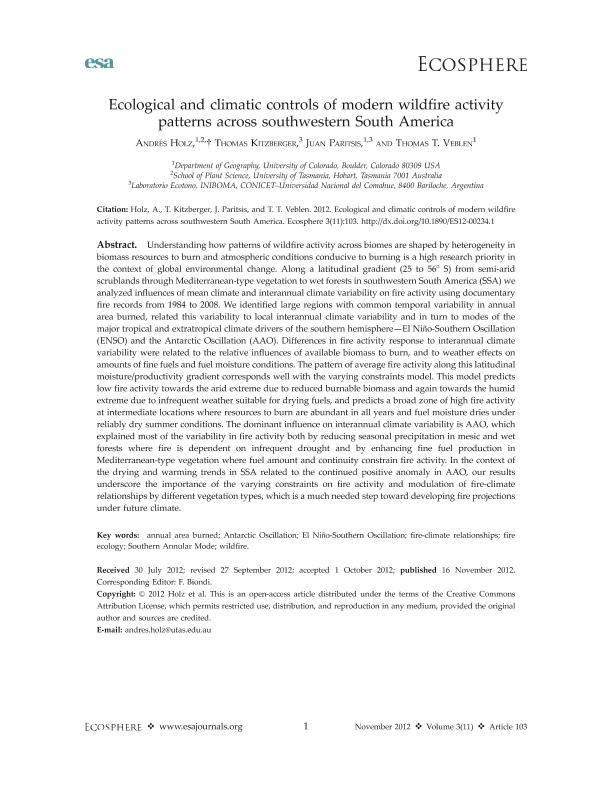Artículo
Ecological and climatic controls of modern wildfire activity patterns across southwestern South America
Fecha de publicación:
16/11/2012
Editorial:
Ecological Society of America
Revista:
Ecosphere
ISSN:
2150-8925
Idioma:
Inglés
Tipo de recurso:
Artículo publicado
Clasificación temática:
Resumen
Understanding how patterns of wildfire activity across biomes are shaped by heterogeneity in biomass resources to burn and atmospheric conditions conducive to burning is a high research priority in the context of global environmental change. Along a latitudinal gradient (25 to 56° S) from semi-arid scrublands through Mediterranean-type vegetation to wet forests in southwestern South America (SSA) we analyzed influences of mean climate and interannual climate variability on fire activity using documentary fire records from 1984 to 2008. We identified large regions with common temporal variability in annual area burned, related this variability to local interannual climate variability and in turn to modes of the major tropical and extratropical climate drivers of the southern hemisphere-El Niño-Southern Oscillation (ENSO) and the Antarctic Oscillation (AAO). Differences in fire activity response to interannual climate variability were related to the relative influences of available biomass to burn, and to weather effects on amounts of fine fuels and fuel moisture conditions. The pattern of average fire activity along this latitudinal moisture/productivity gradient corresponds well with the varying constraints model. This model predicts low fire activity towards the arid extreme due to reduced burnable biomass and again towards the humid extreme due to infrequent weather suitable for drying fuels, and predicts a broad zone of high fire activity at intermediate locations where resources to burn are abundant in all years and fuel moisture dries under reliably dry summer conditions. The dominant influence on interannual climate variability is AAO, which explained most of the variability in fire activity both by reducing seasonal precipitation in mesic and wet forests where fire is dependent on infrequent drought and by enhancing fine fuel production in Mediterranean-type vegetation where fuel amount and continuity constrain fire activity. In the context of the drying and warming trends in SSA related to the continued positive anomaly in AAO, our results underscore the importance of the varying constraints on fire activity and modulation of fire-climate relationships by different vegetation types, which is a much needed step toward developing fire projections under future climate.
Archivos asociados
Licencia
Identificadores
Colecciones
Articulos(INIBIOMA)
Articulos de INST. DE INVEST.EN BIODIVERSIDAD Y MEDIOAMBIENTE
Articulos de INST. DE INVEST.EN BIODIVERSIDAD Y MEDIOAMBIENTE
Citación
Holz, Andrés; Kitzberger, Thomas; Paritsis, Juan; Veblen, Thomas; Ecological and climatic controls of modern wildfire activity patterns across southwestern South America; Ecological Society of America; Ecosphere; 3; 11; 16-11-2012; 1-25
Compartir
Altmétricas




